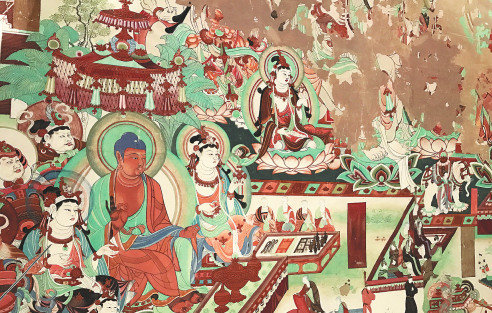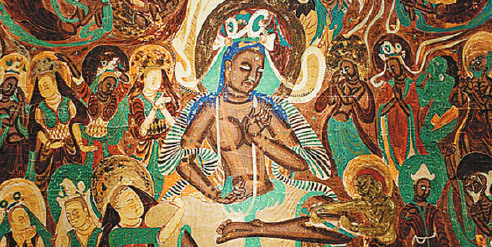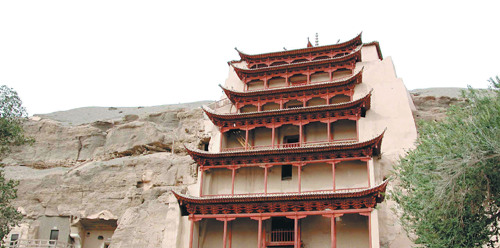
 |
|
The murals in the Mogao Caves are one of the valuable cultural legacies left behind from the city's time as a hub on the ancient Silk Road. [Photo by Chen Yuxiao/For China Daily] |
Moutai's chairman Li Baofang articulates vision for better world forged through expanding cultural and economic exchanges
During the third Silk Road (Dunhuang) International Cultural Expo held in the city of Dunhuang in Gansu province on Sept 27-28, Li Baofang, chairman of Kweichow Moutai Group, shared his insights into how to make the world a better place through cultural and economic exchanges.
When we meet in Dunhuang, a historic city that has played a crucial role in the cultural and economic exchanges between China and the world for more than 2,000 years, we feel the expo we are attending - which bears the name of the Silk Road - is an extraordinary event.
The world today has entered a critical period after the ending of the Cold War in the early 1990s. There are increasing uncertainties in global af airs, considering growing trade frictions and a new trend of anti-globalization.
Here in this hub of ancient cultural exchanges, I believe we can profoundly learn from its past experiences.
More than 2,000 years ago, despite various tough conditions, especially in transportation, merchants from countries and regions along the Silk Road overcame all the adversities to trade commodities.
The ancient trade route was also a great channel for cultural exchanges, which we can feel today when taking in the many cultural relics, such as the Mogao Caves or Thousand Buddha Grottoes, and other places of interest in this city.
The theme of this year's expo is to "showcase the cultural fruits of the Silk Road, facilitate exchanges in the humanities and build the world into a better place to live" - and this is exactly the reason why we are meeting here.
Compared with various periods in history, we are now in an era of information, which makes all kinds of exchanges much easier. With an open mind and a global vision, we should have the confidence to build a better future for all human beings.
From the perspective of an entrepreneur, I'd like to share my opinions on this occasion on how to build a Silk Road in the new era
Openness and courage
Building a Silk Road in the new era demands openness, inclusiveness, courage and confidence.
More than 100 years ago the Chinese people still relied on horses and slow boats for transportation. At that time Moutai representatives traveled from the landlocked Guizhou province in southwestern China all the way to San Francisco on the west coast of the United States, for an exhibition at the 1915 Panama Pacific International Exposition, an event showcasing the world's latest industrial developments and also celebrating the completion of the Panama Canal that connects the Pacific and Atlantic oceans.
The journey to a destination several thousands miles away in San Francisco, where Moutai liquor garnered a gold medal and gained its international reputation, was not easy at all. Behind the success of the brand is our enterprising spirit that is similar to the spirit that motivated the merchants on the Silk Road 2,000 years ago. In addition to this enterprising spirit, our forefathers at Moutai stuck to a humble principle - the competitiveness of products or services comes from the recognition and respect of people in various cultures.
 |
|
Various deities related to the Buddhist culture, including the Flying Apsaras, are depicted in the Dunhuang murals. [Photo by Sun Zhijun/For China Daily] |
Edwin M Lee, former mayor of San Francisco who died last year, considered the exhibition of Moutai at the expo a significant event for the history of his city, which has strong cultural links with the Chinese people.
Moutai's trip to San Francisco, as well as its subsequent recognition as a successful Chinese brand, was monumental in our company's history and gave spiritual support for us to constantly pursue perfection.
In the long history of human civilization, be it the bronze, industrial or information eras, a yearning to go to the outside world is always a driving force for progress.
During the past decades, we experienced a lot of difficulties - isolation, scarcity in material supplies and cultural deprivation - so we long for openness and inclusiveness just like anyone else. We see the Silk Road of the new era as a golden opportunity for opening-up and for bringing benefits to more people in the world.
With such a recognition of the role of the new Silk Road, we still need courage, confidence and perseverance to make our expectations come true.
Despite all the uncertainties in today's global trade, we know that the difficulties we need to overcome are much smaller than those that the pioneers faced some 2,000 years ago. We are confident that we have the wisdom required to create a more friendly environment for business and cultural exchanges.
Golden crossroads
Over the centuries, Dunhuang was at the crossroads for important business and cultural exchanges.
As a hub on the ancient trade route, Dunhuang witnessed the fruitful exchanges of both commerce and cultures. Cultural exchange is the result of international trade and business connections and in turn it helps to promote social prosperity and results in increased openness and inclusiveness.
As in ancient times, such hubs for commercial and cultural exchanges as Dunhuang can still play an important role in today's society and economy. The success of such hubs relies not only on their unique geographical locations, but also on the support of governments.
We are happy to see that Dunhuang is still playing a role in international exchanges. The current Silk Road expo is expected to inject new vigor into the city and the ancient trade route as various cultures meet here, helping to increase understanding among peoples from different countries and regions.
Belt and Road
The new Silk Road Economic Belt and 21st Century Maritime Silk Road, which are also known collectively as the Belt and Road, is a new initiative proposed by the Chinese government for promoting the economic and cultural prosperity of countries along the routes.
During the past few years, Moutai has found great opportunities and ample space for growth through its engagement with the Belt and Road countries and regions.
We have discovered the strength of culture when promoting our brand to the world. We hope in the future that more countries along the Belt and Road can foster more cultural exchanges, making their unique cultures better known to the world. We expect that more win-win collaborations can be developed, based on openness and inclusiveness.
This year marks the 40th anniversary of China's reform and opening-up. During the past four decades, China has made miraculous achievements in both the economic and social fields thanks to the concerted efforts of the Party, the government and the people. Great changes have taken place in this ancient country. Our land has offered a home to the operations of the world's great companies such as Microsoft, Apple and Coca-Cola. Through learning their advanced operational skills and their corporate cultures, a great number of great domestic companies have emerged in the country, such as Tencent, Alibaba and Huawei.
Samuel P. Huntington, the US political scientist and author of the Clash of Civilizations, stated in the 1990s that the conflict between cultures would be the biggest threat to world peace in the future.
However, we might find better solutions to the pressing concerns of the world by learning from the cultural prosperity of Dunhuang and the booming commerce brought by the ancient Silk Road over two millenniums.
Dunhuang was the intersection of three main silk routes in ancient times. As a hub of commerce, it welcomed Buddhism - a foreign religion from India - from the first century AD. While Buddhists used this city as their main stop to spread the religion to the rest of China, they left behind them rich, brilliant cultural legacies, such as the Mogao Caves, as well as a great number of Buddhist manuscripts, murals and statues. As a result, the city at one point became the hub of Buddhism in China.
 |
|
The Mogao Caves are a popular tourist attraction in the city of Dunhuang. [Photo by Cao Zhizheng/For China Daily] |
Another successful example of how a country benefits from cultural and economic exchanges with the world is China's opening-up policy over the past four decades.
Moutai has long been fond of the cultural inclusiveness of Dunhuang. It began to use the image of the Flying Apsara - a female spirit of the clouds frequently depicted in the Dunhuang murals - as its trademark six decades ago. As Moutai goes global, this beautiful Indian goddess known for her elegant dance has also become better recognized by the world.
Grasping the historic opportunity of the Belt and Road Initiative, Moutai is successfully expanding to global markets.
The company has a presence in 26 countries and regions involved in the initiative, with sales there accounting for about one-fifth of Moutai's total overseas sales volume.
With increasing investment in foreign countries, we are creating more jobs for locals and paying more taxes to local governments. In the meantime, we are engaged in corporate social responsibility initiatives in many countries, especially in the field of education - building schools in Mozambique and setting up a scholarship at the University of New South Wales in Australia, to just name a few.
We hope more companies can join us to offer the best products and services to the world, promote our excellent Chinese culture and make the world a better place to live.